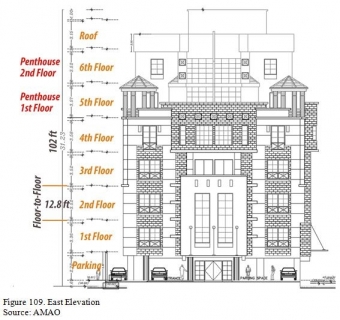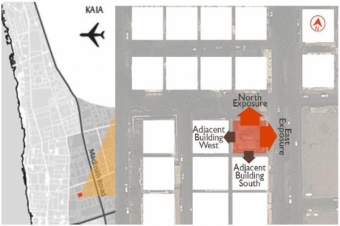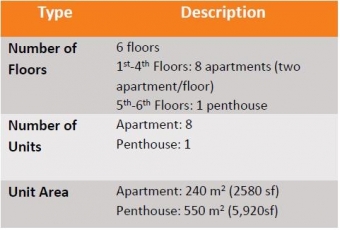Saving the Black Gold (Saudi Arabia)
This project was an entrant in the January 2014 Excellence in Analysis Awards. The project analyzes the design decisions of an existing residential building and through analysis, offers recommendations and guidelines for improving the energy efficiency for new constructions in the region. We’re going to spotlight a few of the analyses we thought deserved honorable mention.
Project Title:
Saving the Black Gold
Project Designers:
Hatim Asim Azzouz
Project Date:
May 2013
Student
Project Scope
This project tested and analyzed how much energy can be saved by applying conservation measures in a typical existing residential apartment building in Jeddah, Saudi Arabia. Through simulation, the project identified the energy consumption of a typical residential building in Jeddah and explored various areas for improvement such as building orientation, shading devices, envelope materials, and internal loads. Many alternatives were studied in order to identify the best energy conservation measures.
The result of the study was to take the information gained and form a set of best practices and recommendations that can be implemented to all new and existing buildings in Jeddah city to reduce the city’s electricity demand.
Defining the Problem
Before diving into performance analysis, this project did a great job of defining the problem and justifying why certain factors were being studied.
Compared to the US, buildings are a larger percentage of electricity consumption in the country. Fifty percent of the buildings are residential buildings. Residential buildings in Saudi Arabia, the world’s largest oil-producing country, consume half of the country’s electricity.
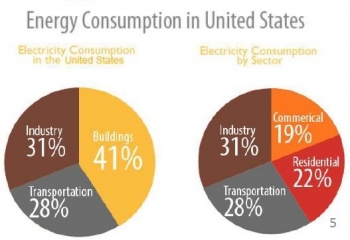 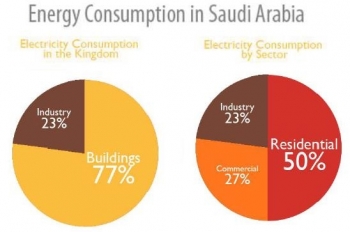 |
| Buildings account for 77% of electricity consumption in Saudi Arabia whereas they account for 41% in the US. |
According to the Saudi Arabian census that was conducted in 2004, the latest census for Jeddah, 61% of the Jeddah population is living in apartments. The total number of apartments in Jeddah is 367,000. According to the Jeddah municipality, the city will need around 953,000 housing units by the end of 2029.
By analyzing the energy use of an existing residential apartment, the information gathered can help inform the new housing units that might be constructed to accommodate the expansion of Jeddah. This has the potential to lead to more energy efficient housing options that can reduce the electricity consumption of buildings in Saudi Arabia.
Comparing Wall Constructions
One of the many analyses conducted in the project was to determine if an alternative wall construction would improve building energy use, more specifically, what would the impact of insulation be.
For most of the year, Jeddah is considered a hot and humid climate. As a result, Jeddah is a cooling dominated climate, and understanding how to reduce cooling loads will have the greatest impact on decreasing energy use.
The existing building does not have any kind of wall insulation. The existing wall construction consists of three layers: exterior cement plaster, hollow red clay brick, and interior cement plaster.
The three most common wall assembles in Jeddah were selected to compare to the existing wall assembly to determine if there was a variation in performance. The alternative wall assemblies were: concrete block wall (Alt 1), insulated red hollow clay brick wall with 50mm of Extruded Polystyrene (Alt 2), and insulated red hollow clay brick wall with 75mm of Extruded Polystyrene (Alt 3). The assemblies were tested in Ecotect to determine which one reduces cooling loads the most.
The impact was calculated for three different zones.
- The Penthouse (5th-6th floors)
- The 4th floor (north and south positioned apartments)
- The 3rd floor (north and south positioned apartments), the results for the 3rd floor will be multiplied by the number of apartments that have the same orientation to get the total building cooling load.
When wall Alternative 1 was applied, there was a significant increase in cooling loads, an average of 11.6%. On the other hand, when wall Alternative 2 was added to the building, it showed a significant reduction from the building’s baseline with an average of 17%. Wall Alternative 3 was also tested, but it showed no noticeable difference from Alternative 2.
Alternative 2, insulated red hollow clay brick, was selected as a best practice option for future constructions. It has a total annual saving of 17% and 79,614 kWh cooling load reduction when compared to a red hollow clay brick wall.
 |
| Different wall alternatives compared by the cooling load measured in Ecotect. |
This project demonstrated that the energy use of a typical residential building in Jeddah can be reduced through energy conservation measures. Furthermore, the energy conservation measures can be summarized in best practices and recommendations to improve the current and existing residential building stock in Jeddah.
Tips from Hatim
•Verify the material properties of the materials in the Ecotect library before using them. You’ll likely find that you’ll want to make modifications, or create your own materials.
More about the analyst
Hatim Azzouz, Associate AIA, graduated from King Fahd University of Petroleum and Minerals in 2008 with a Bachelor’s degree in Architecture. He worked as a design architect at Zuhair Fayez Partnership for 2 years after graduation. In 2010, he moved to the United States of America to pursue his Master’s degree in Sustainable Design from the Catholic University of America. While studying, he received the Autodesk Building Performance Analysis Certificate in March 2013. This project was conducted for his Master’s thesis. Today, Hatim is a sustainability architect at Zuhair Fayez Partnership.
Comments

